Make & Maintain A Small Sourdough Starter (Mini Starter)
This post may contain affiliate links.
If you're wondering how to make a small sourdough starter, or even reduce the sourdough starter you currently have, then these are the instructions you need. A mini sourdough starter is a good idea, whether you're looking to create less waste, spend less of flour or even just want a little more flexibility with the size of your starter.
You can use simple ingredients to create your very own small sourdough starter, with plenty of bubbles and the goodness of wild yeast to raise your dough. This small sourdough starter recipe is based on my regular sourdough starter instructions which have helped thousands of people create their very own homemade sourdough starter. And if you love having things on a smaller scale, you might like to try this small batch sourdough bread with your mini sourdough starter.
If you are new to the world of sourdough, then I highly recommend these posts as some background readings that will help you on your sourdough journey:
- where does the yeast in sourdough starter come from?
- how to strengthen a sourdough starter
- is the float test really necessary?
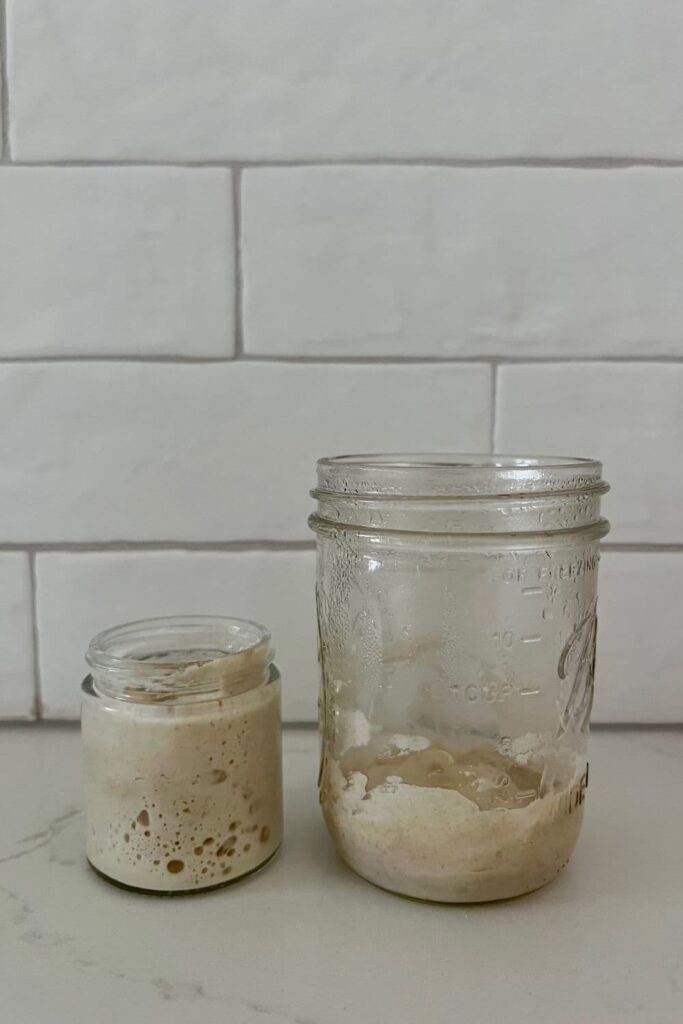
Benefits of A Small Sourdough Starter
There are many benefits to creating and maintaining a small sourdough starter, including:
- using less flour (great for sourdough on a budget)
- creating less discard or waste
- can use more expensive organic flour or rye flour
- more flexible (you can build it up when you need to)
- less mess
Necessary Equipment for Making Small Sourdough Starter
While making your own small sourdough starter is very easy, there are a few things you'll need to have on hand to ensure you are successful in this fermentation process. I recommend you have:
- 2 small, clean jars (mason jar is perfect - you can find my guide to the perfect sourdough container here)
- digital kitchen scale with tare button
- white silicon jar spatula
- rubber band
While some recipes use volume measures (for example a cup of flour), I only weigh my ingredients for sourdough. This is a much more accurate way to measure your ingredients and will ensure that your sourdough starter is fed correctly each time.
Using volume measurements can cause your starter to be given too much water, which over time will result in a runny, starving starter that will not make bread rise.
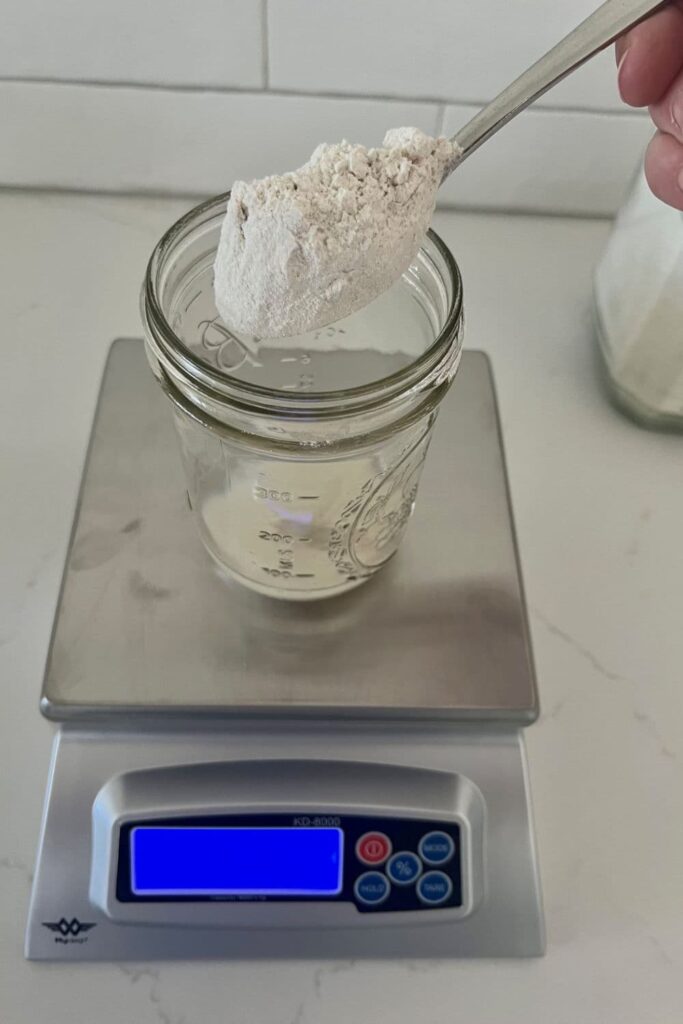
What Flour is Best for A Smaller Starter?
You can use any flour to make your own sourdough starter, including all purpose flour, whole wheat flour or whole grain flour, bread flour, rye flour - or even a blend of these flours. The most important thing is that the flour you use is unbleached. I have successfully made a sourdough starter from all purpose flour, bread flour, spelt flour and rye flour with no issues.
For a quicker starter, I do recommend use some rye flour in your starter, however it is not absolutely necessary.
You can read more about the best flour for sourdough bread here, as well as how to feed your sourdough starter different flours here.
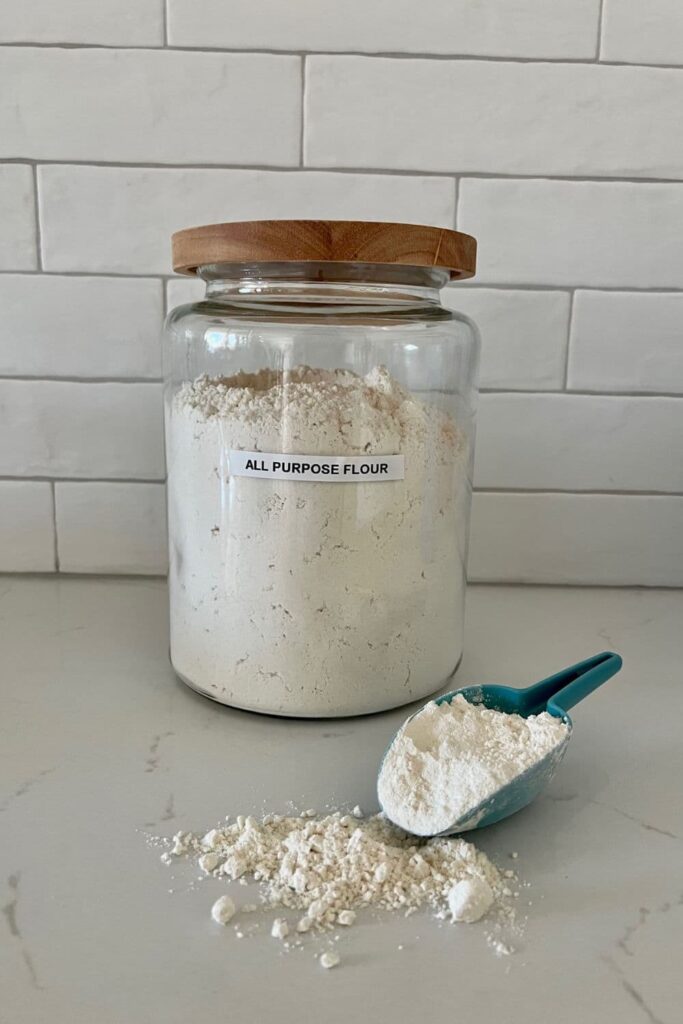
How To Make a Small Sourdough Starter (step-by-step instructions)
Making a small sourdough starter is really quite easy, it's just a case of reducing the amounts of flour and water you use to something you're more comfortable with.
I generally suggest using 50 grams of flour and 50 grams of water to create a sourdough starter, however, this can be too much for some home bakers. Reducing the amounts of flour and water down to 20g each will give you a small sourdough starter that you can build on.
One of the most important things you can do for your small sourdough starter is to keep it in a warm spot. Ideally, you should keep your sourdough starter around 24 to 28C. This will bolster the fermentation process and ensure that your yeast and bacteria colonies are established much faster. You can find some good ideas for keeping your sourdough starter warm here.
DAY 1:
All you need for today is 20g of water and 20g of flour plus a clean jar.
Mix the water & flour together in the jar, pop the lid on loosely (or a piece of paper towel & elastic band). Place the starter somewhere warm for the next 24 hrs.
You'll find ideas for how to keep your starter warm here.
DAY 2:
Once your starter is 24 hours old, you need to check on it and give it a good stir.
You do not need to add anything today - just get some oxygen into your mixture and then recover it and pop aside for another 24 hours.
Your starter may already have some bubbles forming - this is a great sign. But it's also totally fine if it's not doing anything. Time is everything!
DAY 3:
On day 3 remove half of your starter (20g) and then add 20g of flour and 20g of water to the remaining 20g of starter in your jar (so there will be 60g in the jar).
Mix it together, being sure to get lots of oxygen into your mixture. Replace the cover and pop it away until tomorrow.
DAY 4:
Step 4 is to feed your starter in the same way as you did yesterday. Remove 40g of your starter (so there is 20g left in the jar) and then add 20g of flour and 20g of water to the remaining 20g of starter in your jar.
Mix it all together and replace the cover.
You’ll need to do this twice today, around 12 hours apart. While your starter will be fairly forgiving, set a reminder on your phone if you think you’ll forget it’s just like having a pet.
DAY 5:
Step 5 is to feed your starter in the same way as you did yesterday.
Remove 40g of your starter and then add 20g of flour and 20g of water to the remaining 20g of starter in your jar.
Mix it all together and replace the cover.
You’ll need to do this twice today, around 12 hours apart. It's a good idea at this stage to pop an elastic band around the jar you are using. Put the elastic band at the level of your starter when you feed it. This helps you to be able to see how far your starter is rising when it peaks.
DAY 6:
Step 6 is to feed your starter in the same way as you did yesterday.
Remove 40g of your starter and then add 20g of flour and 20g of water to the remaining 20g of starter in your jar. Mix it all together and replace the cover.
You’ll need to do this twice today, around 12 hours apart.
DAY 7:
YAY! Your sourdough starter is a whole week old. Keep feeding twice a day as you have been for at least 14 days.
Now I know you want to get to baking bread … but just remember that the most important thing about this whole process is time. Your starter will be viable after 14 days, however, it will take much longer before it makes really great sourdough bread!
You need to keep feeding your starter the same way as you have been, twice a day (discarding before you feed) until it's consistently doubling within around 2-6 hours after you've fed it. Once it's consistently doubling after every feed you can try and bake with it. Your starter will keep maturing as you use it.
For more information on how to know when your starter is ready, go here.
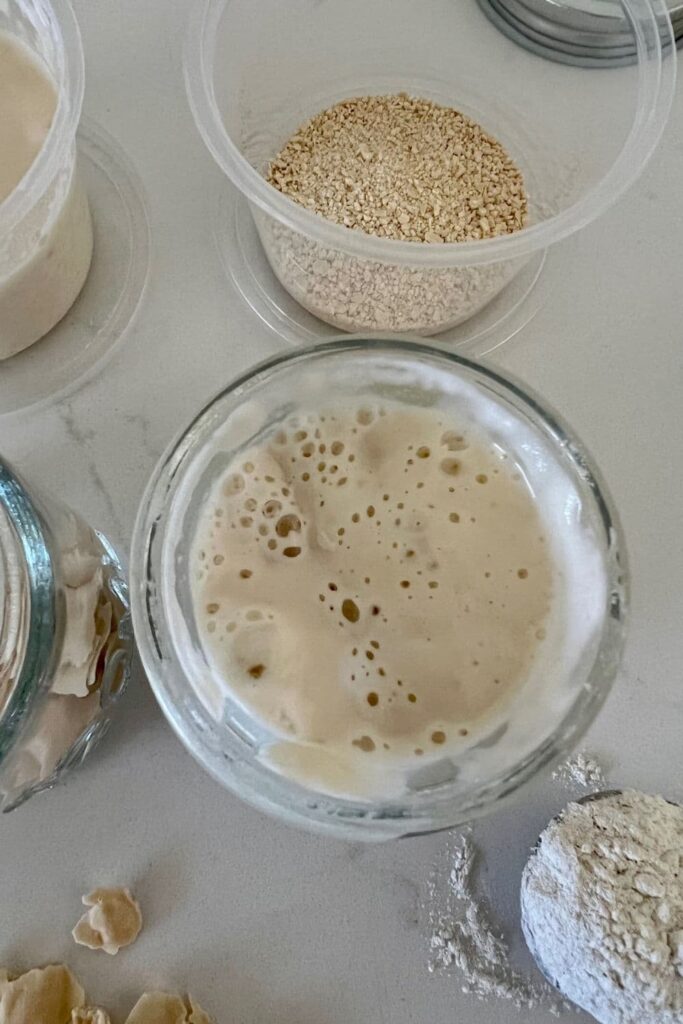
How Can I Increase My Starter When I Need Extra for Recipes?
Having a smaller sourdough starter gives you the flexibility to only keep a bit of starter on hand and then increase your starter when you need to. For example, if you just have 60 grams of starter on hand, but you want 200 grams of starter to make a few different recipes at a time, then you can just add extra to your jar. So you would discard 30g of starter, leaving you with 30g and then you would add 100g of flour and 100g of water.
Once it peaks, you can take out your 200g of active starter and then you're left with 30g which you can feed and keep for your next bake.
My Starter Is Too Big ... How Can I Make It Smaller?
If you are making or even maintaining a sourdough starter and you feel like it's too big and you're using too much flour, you can always reduce it down to a smaller size.
All you need to do is take 20g of the starter you already have and then feed it with 20g of flour and 20g of water (so 1:1:1). Then you'll have a 60g starter, which is considered a smaller amount.
You can of course reduce these amounts even further if you wish, but this is a reasonable size to keep waste to a minimum.
Do I Still Have To Discard A Small Sourdough Starter?
Yes, even with a small sourdough starter, you still need to discard your starter before each feed. A smaller sourdough culture means that when you do discard, you will create less waste. Of course you can always use your sourdough discard in these sourdough discard recipes. You can save several different days of sourdough discard to use in a recipe if you want to.
What If I Run Into A Problem?
Making a sourdough culture can be a longer process than you might have imagined, and while it uses simple ingredients, problems can arise from time to time.
Problems like seeing mold on your starter, finding liquid on the surface of your starter or not seeing any activity at all.
I've put together a list of common sourdough starter problems here - they are common no matter what size starter you're trying to make!
Sourdough Recipes for a Small Starter
You can use your small sourdough starter in any sourdough recipe you like, even if you have to build your starter up a little first.
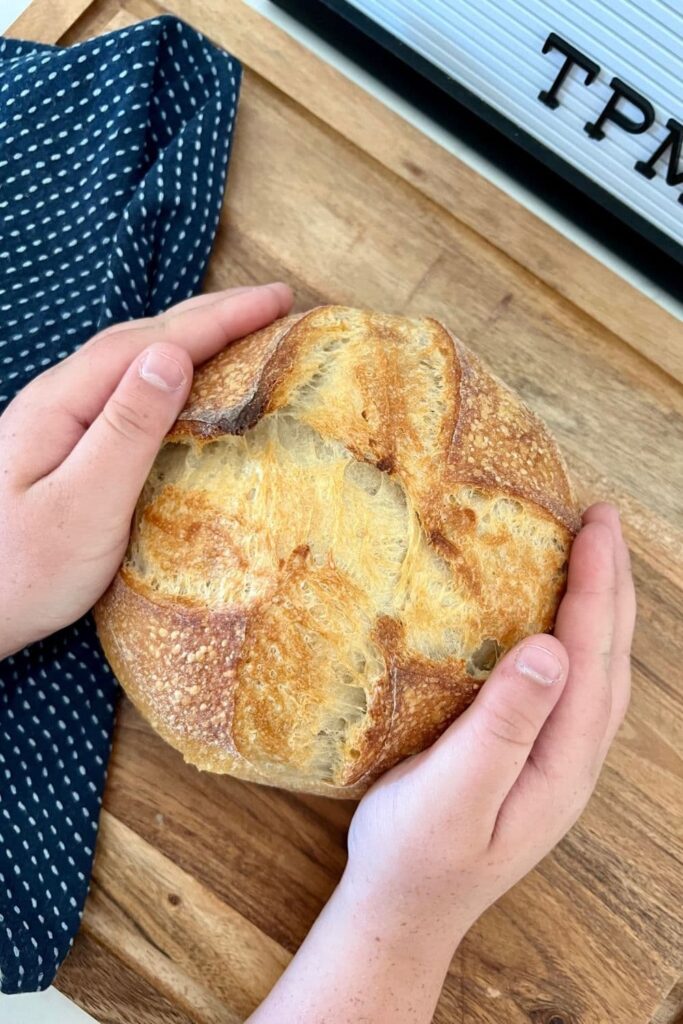
The best sourdough recipes for a small sourdough starter are:
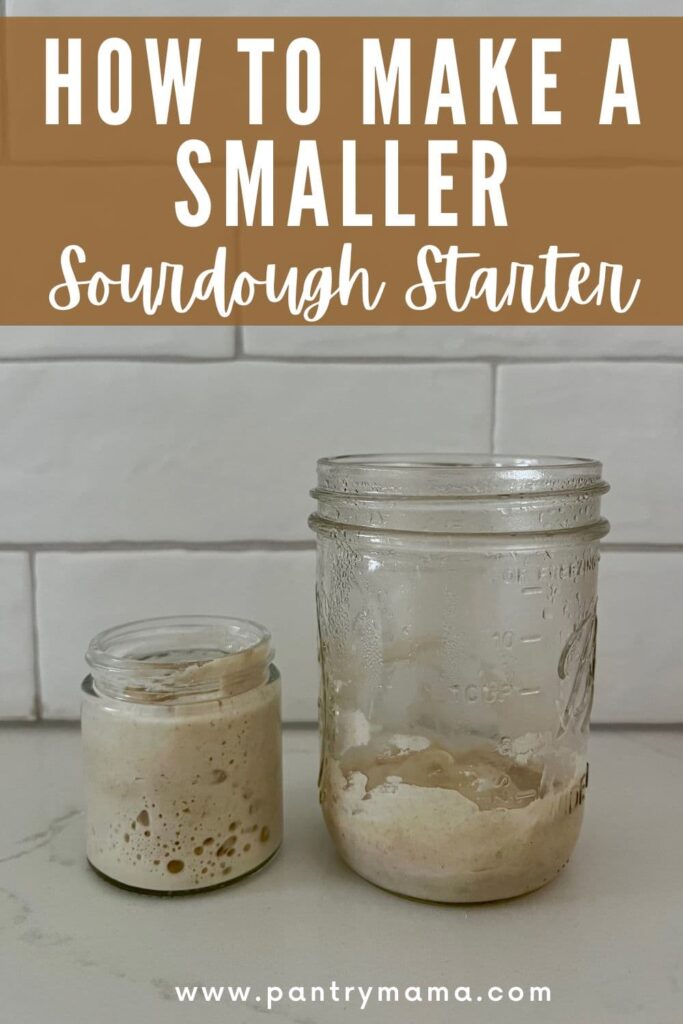
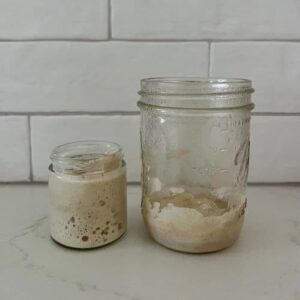
How To Make A Small Sourdough Starter
Equipment
- Clean Jar
- Digital Scales
- Silicone Spatula
Ingredients
- 20 g Flour Bread, All Purpose, Rye, Whole Wheat - whatever you'd prefer
- 20 g Water Filtered
Instructions
- DAY 1:All you need for today is 20g of water and 20g of flour plus a clean jar. Mix the water & flour together in the jar, pop the lid on loosely (or a piece of paper towel & elastic band). Place the starter somewhere warm for the next 24 hrs. You'll find ideas for how to keep your starter warm here.
- DAY 2:Once your starter is 24 hours old, you need to check on it and give it a good stir. You do not need to add anything today - just get some oxygen into your mixture and then recover it and pop aside for another 24 hours.Your starter may already have some bubbles forming - this is a great sign. But it's also totally fine if it's not doing anything. Time is everything!
- DAY 3:On day 3 remove half of your starter (20g) and then add 20g of flour and 20g of water to the remaining 20g of starter in your jar (so there will be 60g in the jar).Mix it together with the end of a wooden spoon, being sure to get lots of oxygen into your mixture. Replace the cover and pop it away until tomorrow.See notes below for more info on using a clean jar vs same jar.Don’t worry if you keep checking it - it’s completely normal It’s good to notice how it changes in shape, size and smell over the 24 hours.At this stage it's completely normal for it to smell really bad and to have developed a layer of liquid on top (this is called hooch). It might look like the water has separated from the flour but it's just telling you that it's hungry. Stir the hooch in when you feed your starter. It's also quite normal for it to double in size. Keep going - it will be fine
- DAY 4:Step 4 is to feed your starter in the same way as you did yesterday. Remove 40g of your starter (so there is 20g left in the jar) and then add 20g of flour and 20g of water to the remaining 20g of starter in your jar. Mix it all together and replace the cover. You’ll need to do this twice today, around 12 hours apart. While your starter will be fairly forgiving, set a reminder on your phone if you think you’ll forget it’s just like having a pet.
- DAY 5:Step 5 is to feed your starter in the same way as you did yesterday. Remove 40g of your starter and then add 20g of flour and 20g of water to the remaining 20g of starter in your jar. Mix it all together and replace the cover. You’ll need to do this twice today, around 12 hours apart. It's a good idea at this stage to pop an elastic band around the jar you are using. Put the elastic band at the level of your starter when you feed it. This helps you to be able to see how far your starter is rising when it peaks.
- DAY 6:Step 6 is to feed your starter in the same way as you did yesterday. Remove 40g of your starter and then add 20g of flour and 20g of water to the remaining 20g of starter in your jar. Mix it all together. Replace the cover. You’ll need to do this twice today, around 12 hours apart.
- DAY 7:YAY! Your sourdough starter is a whole week old. Keep feeding twice a day as you have been for at least 14 days.Now I know you want to get to baking bread … but just remember that the most important thing about this whole process is time. Your starter will be viable after 14 days, however, it will take much longer before it makes really great sourdough bread!You need to keep feeding your starter the same way as you have been, twice a day (discarding before you feed) until it's consistently doubling within around 2-6 hours after you've fed it. Once it's consistently doubling after every feed you can try and bake with it. Your starter will keep maturing as you use it.For more information on how to know when your starter is ready, go here.
Notes
Nutrition

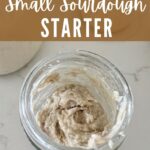
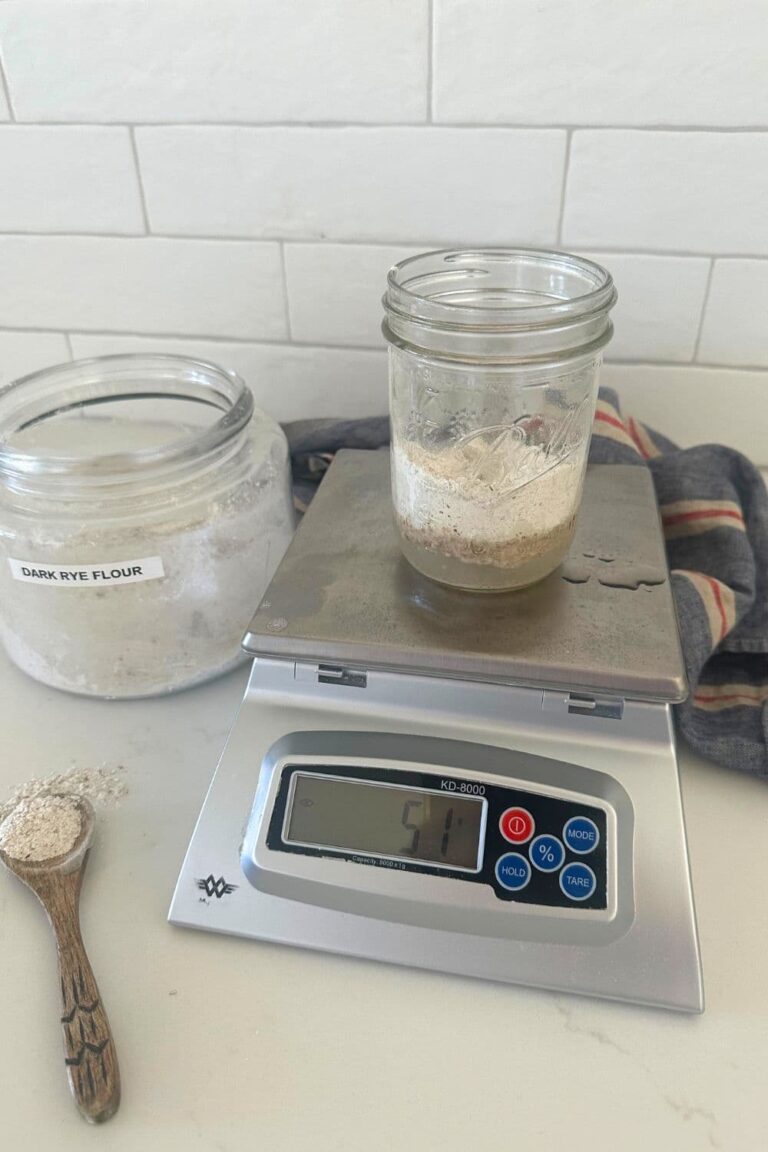
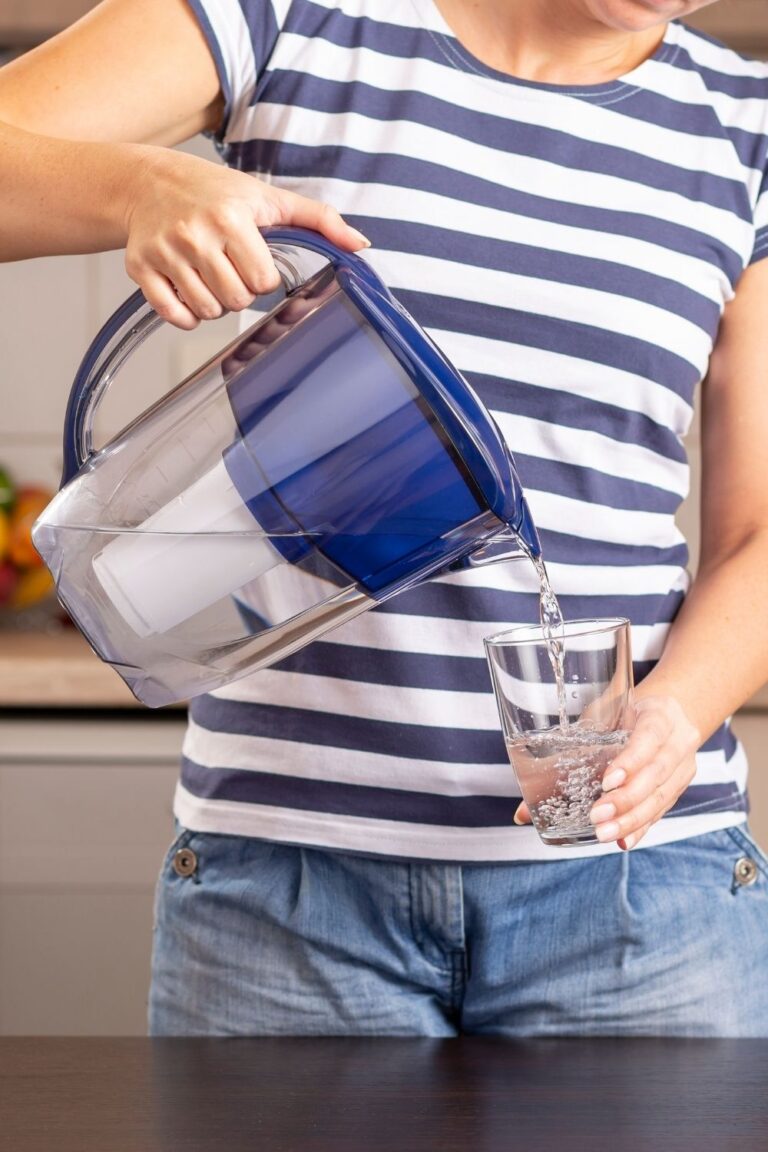
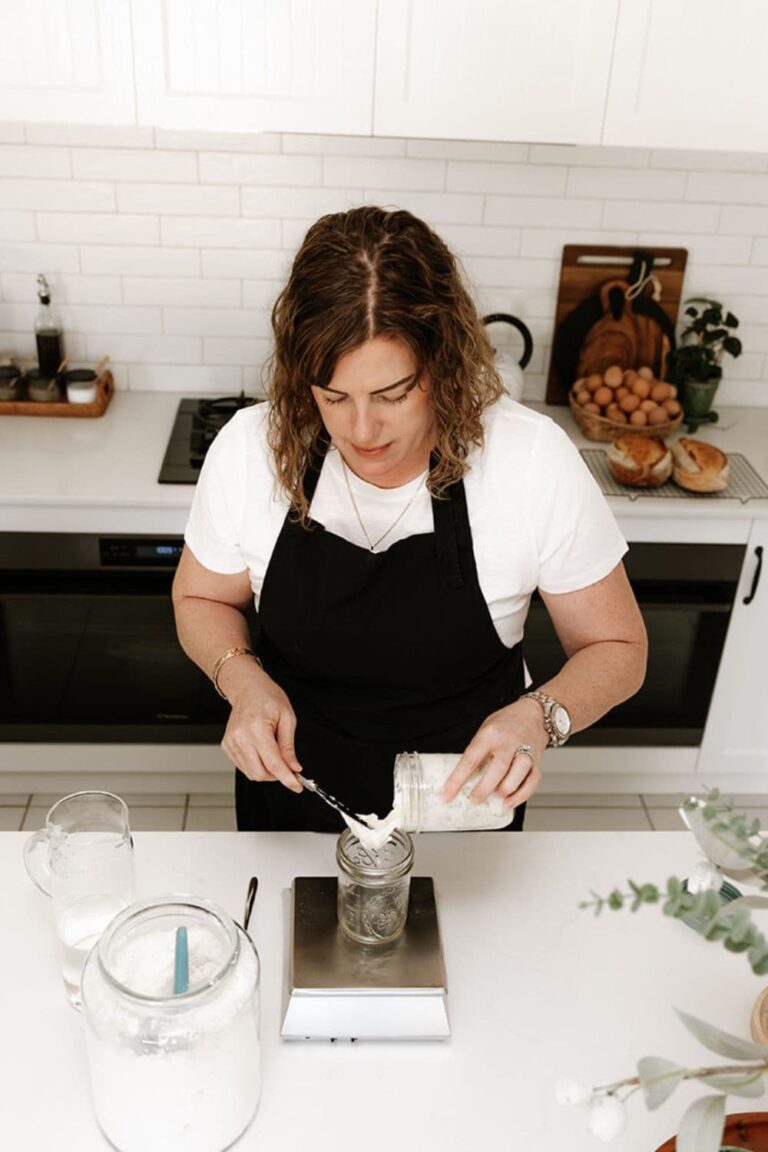
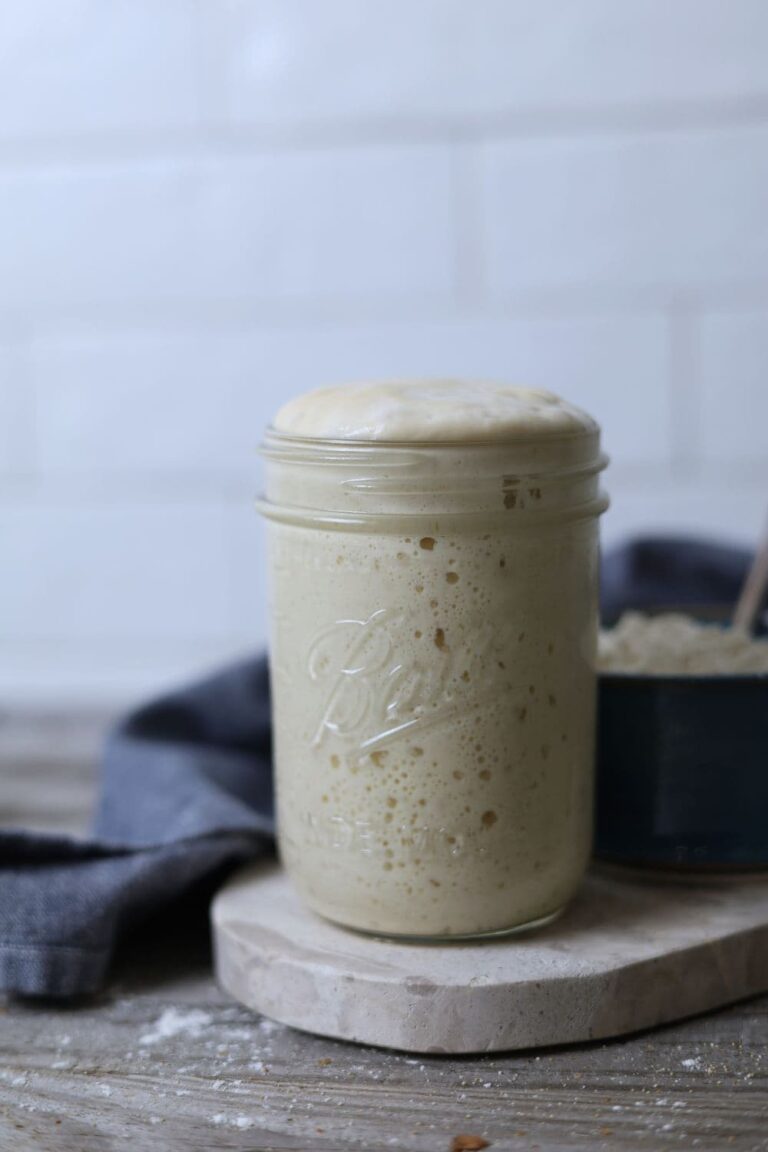
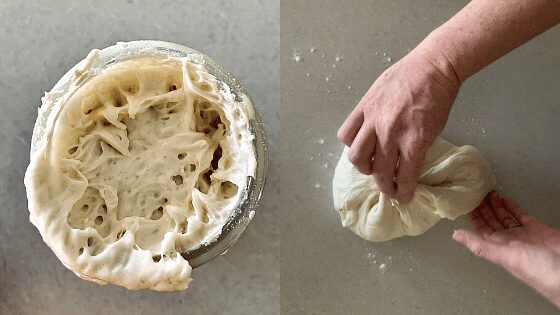
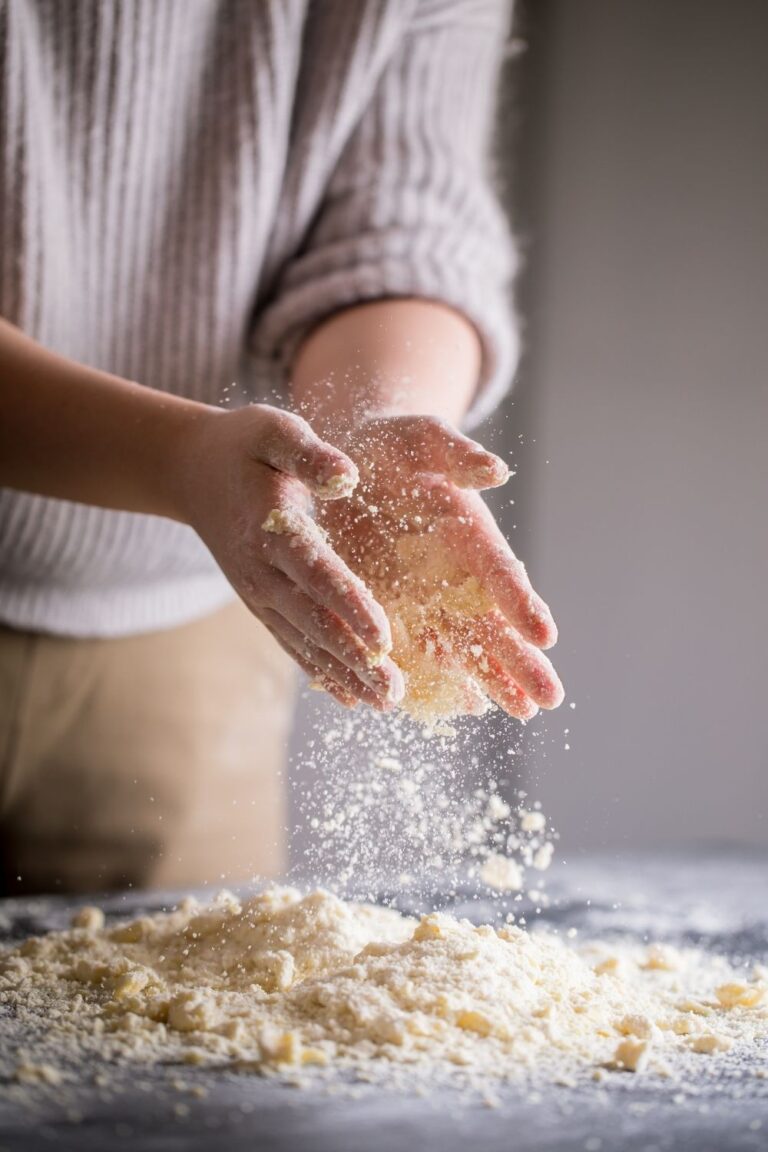

I'm new to sourdough and failed on my first attempt to make rye flour sourdough starter. I'll be trying your method soon, thank you for sharing your method so precisely, I think it will work for me this time.
I wish I had found your website yesterday! I fell prey to the "make sourdough bread in a week" program and I'm using starter that's almost 2 weeks old. My first dough is resting after the second stretch and pull. My starter has been yielding more discard than I can use and I have 2 loaves of discard and active yeast in the oven right now. I will follow your method to reduce the size of my starter, and will use some of your tips to strengthen it before I try again. I don't hold out much hope for today's loaf, but will do my best to salvage it.
I am not understanding the discard idea. Do you just throw it out? The first discard says to take out half and add 20g flour and 20g water. You then said it will be 60g. It does not add up for me. I am very confused. Sorry, this is my first time trying this.
I am on day 4 and I do not see any bubbles appearing, am I doing something wrong? I am using a jar with a cloth cover and keeping it in a warm location.
I am only on day two and the top of my starter is hard and leathery. Should I remove that part? (I did today - but wondering if that’s normal or something I should expect in the future) or if I have it in the wrong space. I have it in the warmest room but it’s also dry in here right now.
This can happen from too much air interacting with the surface of your dough. Definitely remove it, but if it keeps happening, swap the paper towel for a loose fitting lid 🙂
This is probably the most detailed beginner sourdough starter recipe I have ever seen!! Previously, I thought I had made mistakes with other recipes, resulting in me throwing out my perfectly good starter because I thought it had gone bad when in reality, it was doing its job. This post has made me realize otherwise and has given me the encouragement to continue developing my starter. Overall, I highly recommend if you a beginner as it is super encouraging and detailed! You can really tell that this post was made with lots of care and thought.
Thanks for all your helpful tips!